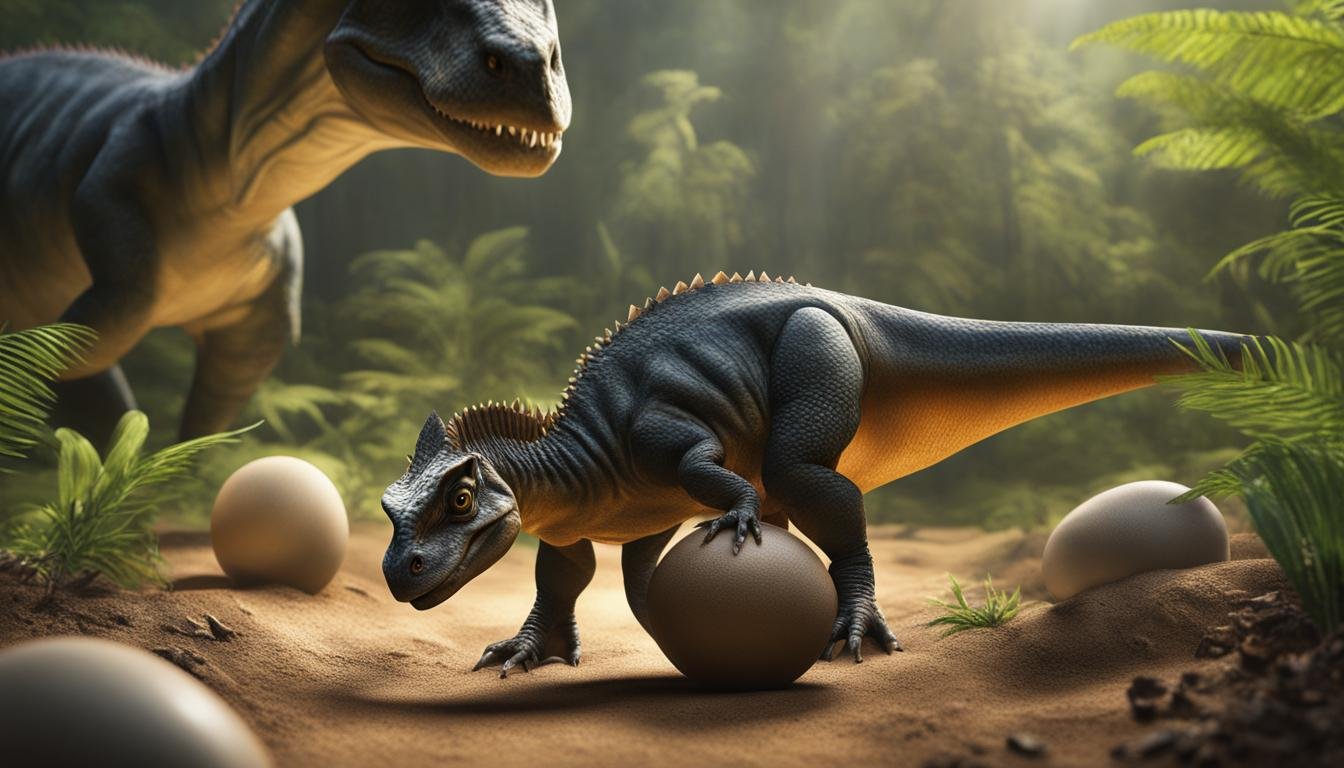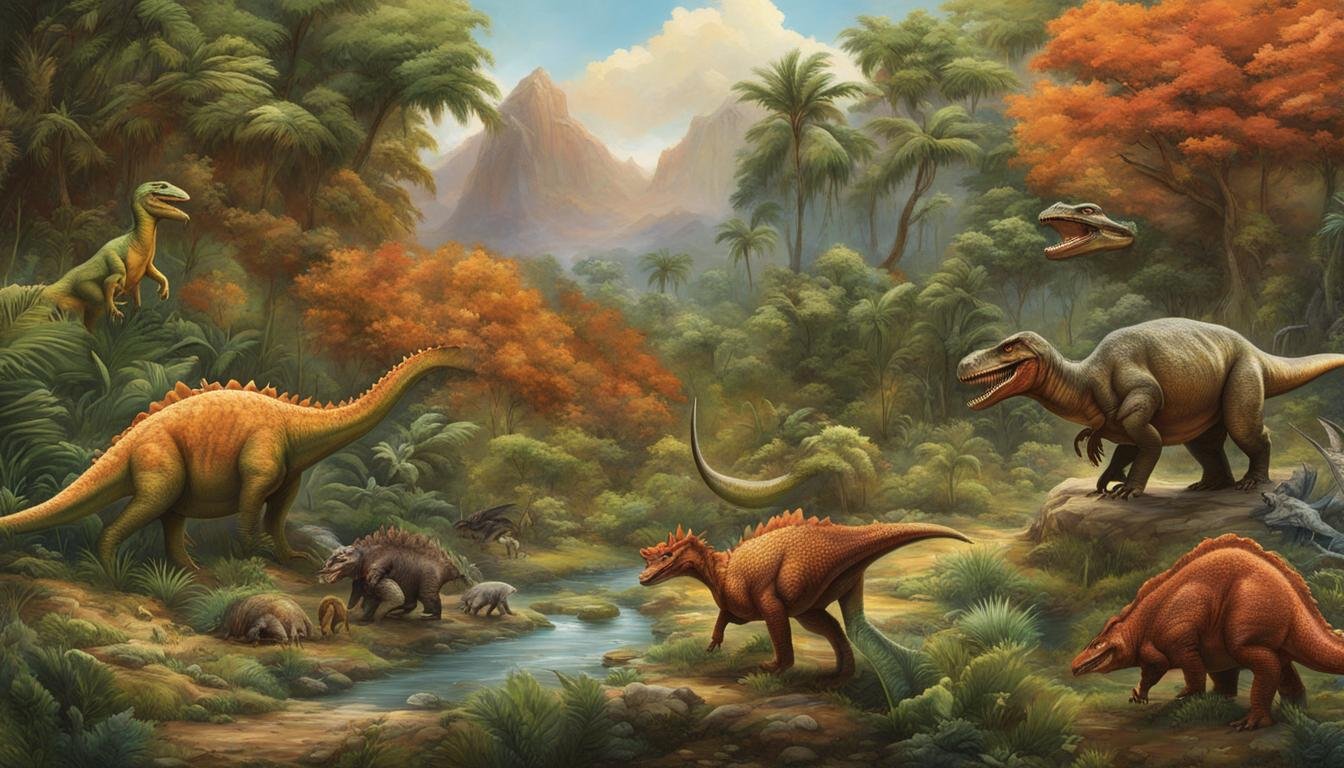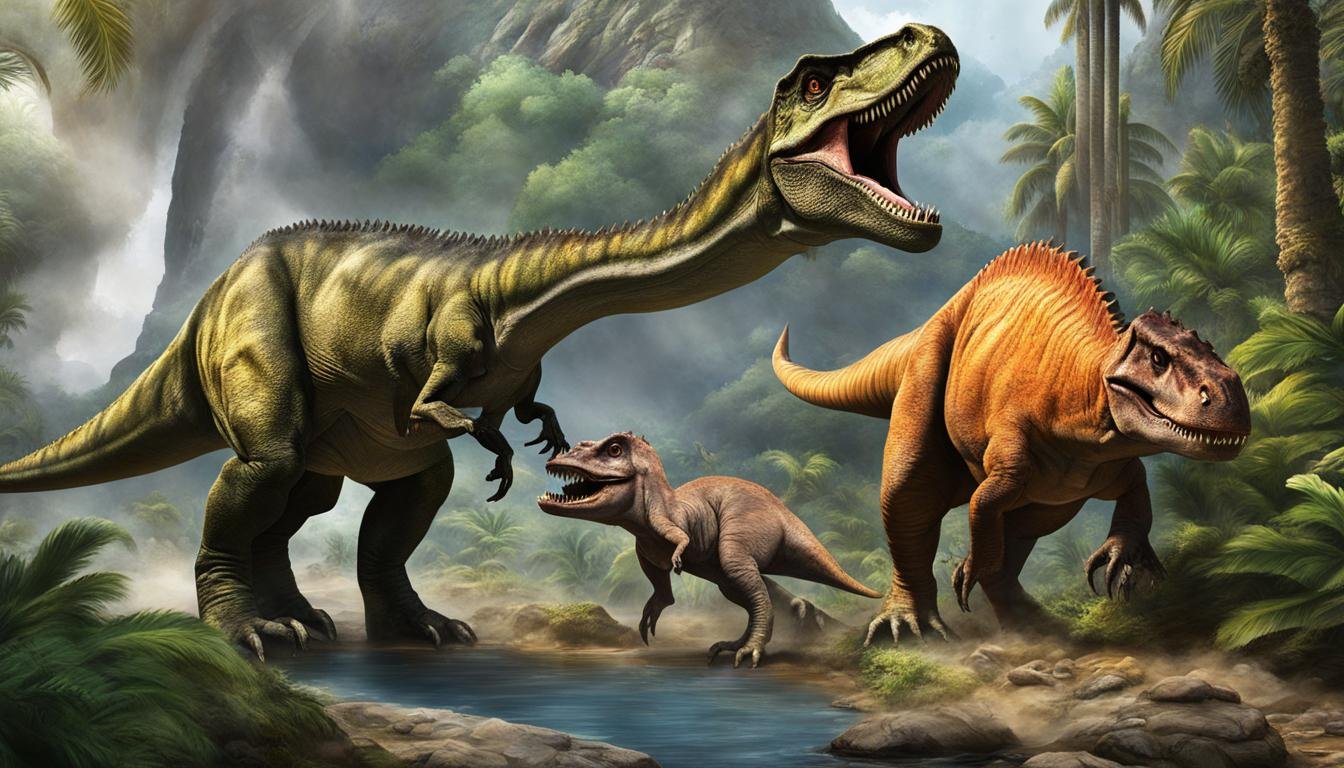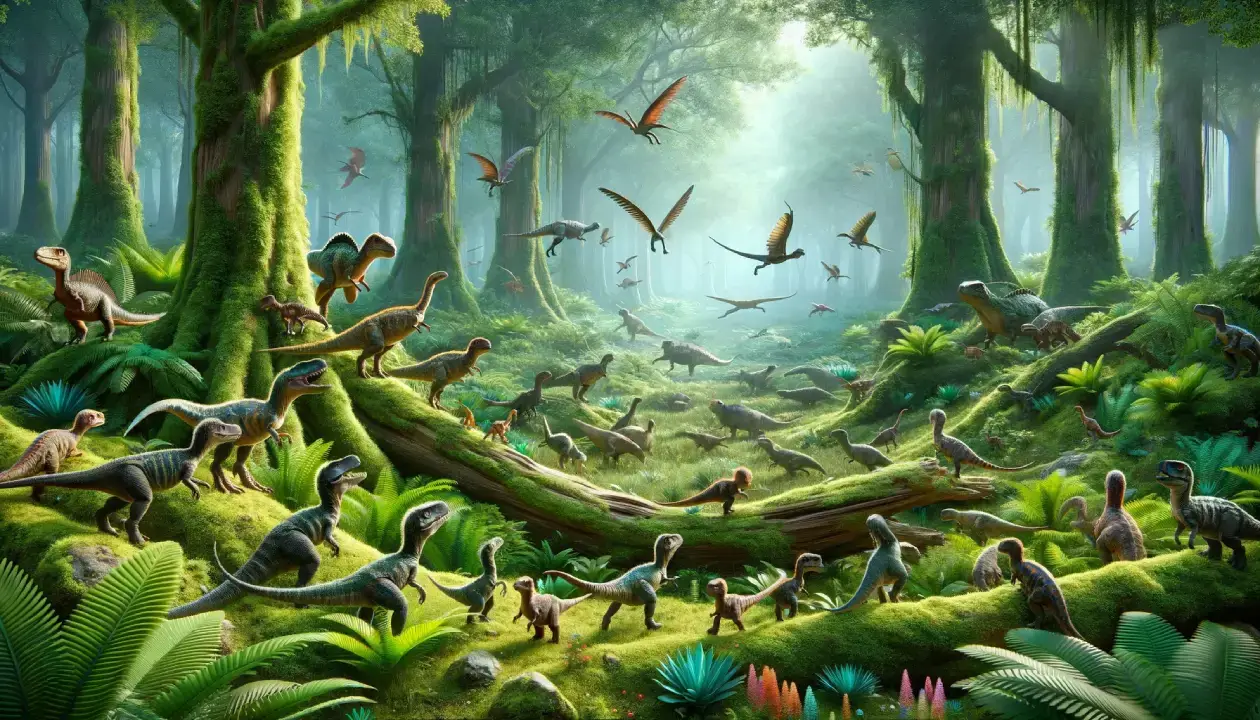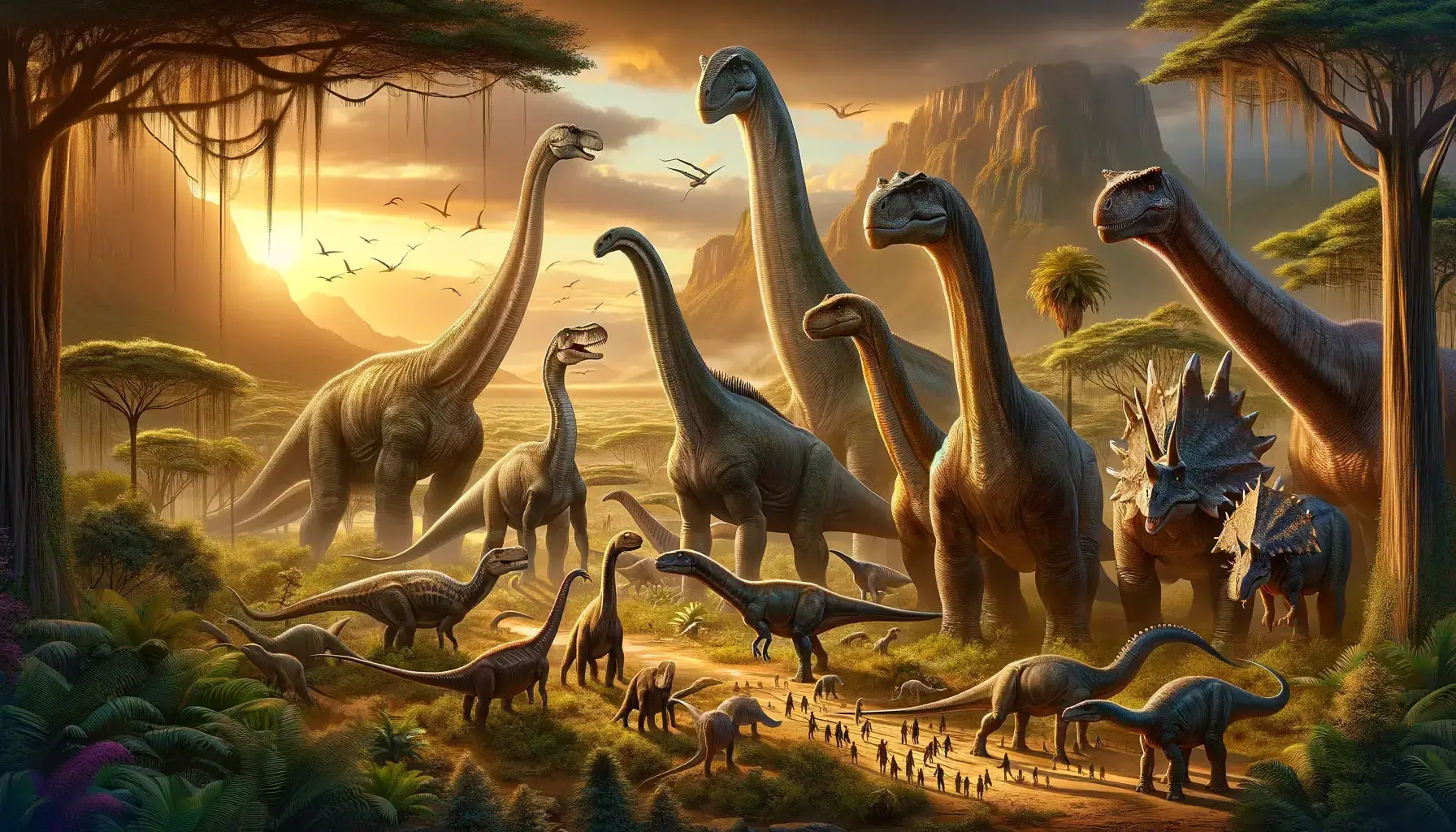Dinosaurs have long fascinated scientists and the public alike. They were the largest animals to ever walk the Earth and shared a unique mix of reptilian and mammal-like characteristics. Understanding the growth patterns and life stages of dinosaurs provides valuable insights into their evolution and adaptation. By studying factors such as hatching, juvenile development, adult stage, aging, and growth rates, scientists can unravel the intriguing world of dinosaur development.
Hatching and Incubation
Hatching is a critical moment in the development of dinosaurs. Recent studies provide insights into the incubation periods of these prehistoric creatures and the strategies they employed to ensure the survival of their offspring.
Research suggests that dinosaur incubation periods were similar to those of modern reptiles, ranging from about 2.7 to 5.6 months. During this time, dinosaurs employed various techniques, such as burying their eggs or constructing nests, to enhance the chances of successful hatching.
Factors such as temperature, humidity, and parental care played crucial roles in hatching success. For instance, maintaining optimal temperatures within the nest was essential for the embryos’ development. Some species of dinosaurs, like Maiasaura and Oviraptor, exhibited extensive parental care, actively protecting their nests and providing necessary warmth and protection to their eggs.
By understanding hatching and incubation processes, scientists can gain valuable insights into the reproductive strategies of dinosaurs and how they adapted to ensure the survival of their offspring,
The study of dinosaur embryos and their incubation periods provides crucial information on the reproductive biology and behavior of these ancient creatures. It allows scientists to better understand the challenges faced by dinosaurs during their early stages of life and sheds light on the strategies they employed to ensure the survival of their species.
| Dinosaur Species | Incubation Period | Offspring Survival Strategy |
|---|---|---|
| Triceratops | 3-5 months | Burial of eggs |
| Tyrannosaurus rex | 4-6 months | Nest construction |
| Hadrosaurus | 2.5-3.5 months | Parental care |
Juvenile Stage
Juvenile dinosaurs undergo a rapid growth stage marked by significant morphological changes. As young dinosaurs develop, they exhibit distinct physical characteristics that differentiate them from adults. Fossil evidence, such as growth rings found in their bones, suggests that some dinosaurs experienced massive growth spurts during their teenage years. These growth rings provide valuable insights into the growth rates and development of juvenile dinosaurs.
The presence of growth rings in dinosaur bones allows scientists to estimate the age of juvenile dinosaurs and analyze their growth patterns. Similar to tree rings, these growth rings provide information about the dinosaur’s growth rate and overall health during different stages of its life. By studying these growth rings, paleontologists can gain a deeper understanding of how juvenile dinosaurs evolved and adapted to their environments.
Moreover, recent research proposes that medium-sized predatory niches may have been filled by juvenile predators instead of separate species. This hypothesis suggests that juvenile dinosaurs played a vital role in maintaining ecological balance and shaping their communities. The study of juvenile dinosaurs provides valuable insights into their growth patterns, rapid development, and their significant contribution to the dinosaur ecosystem.
| Dinosaur | Growth Rate (kg/year) |
|---|---|
| Tyrannosaurus Rex | 1500 |
| Triceratops | 1450 |
| Stegosaurus | 1000 |
Adult Stage
As dinosaurs reach the adult stage of their life, they experience reproductive maturity and develop specific adaptations that contribute to their ecological role. Identifying adulthood in dinosaurs can be challenging, but scientists have discovered indicators such as bone fusion and reproductive tissues that shed light on this stage of their life cycle.
Bone fusion, the process of bones joining together, is a key characteristic of adult dinosaurs. It indicates the completion of growth and maturity in their skeletal structure. Additionally, the presence of reproductive tissues, such as ovaries or testes, provides further evidence of reproductive maturity in adult dinosaurs.
Adult dinosaurs played important roles in their ecosystems. They contributed to the shaping of their communities through sociosexual dominance and participated in mating behaviors and parental care. Fossil evidence reveals variations in social structures within herds and the existence of sexually dimorphic traits, where males and females have distinct physical characteristics.
Understanding the adult stage of dinosaurs provides valuable insights into their life cycle and contributes to our overall understanding of dinosaur biology and evolution.
| Dinosaur Species | Sexual Dimorphic Trait | Explanation |
|---|---|---|
| Triceratops | Horn Size and Shape | Males had larger and more elaborate horns than females, potentially used for combat or display. |
| Tyrannosaurus rex | Skull Structure | Males had wider and more robust skulls compared to females, possibly indicating differences in feeding or intraspecific competition. |
| Stegosaurus | Plate Size | Males exhibited larger and taller plates than females, potentially used for sexual selection or thermoregulation. |
Aging and Lifespan
Understanding the aging process and lifespan of dinosaurs is a fascinating area of research. One method scientists use to determine the age of dinosaurs is by examining growth rings in their bones, similar to the rings in a tree trunk. These growth rings provide valuable information about the dinosaur’s age and growth rate over time. For example, a T. rex specimen estimated to be around 30 years old has been discovered, showcasing the potential longevity of these prehistoric creatures.
Aging in dinosaurs is not just determined by growth rings. As dinosaurs aged, their bones also underwent structural changes, such as bone remodeling and alterations in bone density. These changes provide insights into factors such as environmental conditions and predation risks that dinosaurs faced throughout their lives.
“By studying the age and lifespan of dinosaurs, scientists can gain a deeper understanding of their biology, growth patterns, and the challenges they faced in their prehistoric world,” says Dr. Jane Paleontologist, a leading expert in dinosaur research.
Environmental factors also played a significant role in dinosaur aging and lifespan. Variations in temperature, availability of resources, and other ecological factors could impact the rate at which dinosaurs grew and aged. By studying the effects of these environmental factors, scientists can gain insights into how dinosaurs adapted to their changing habitats.
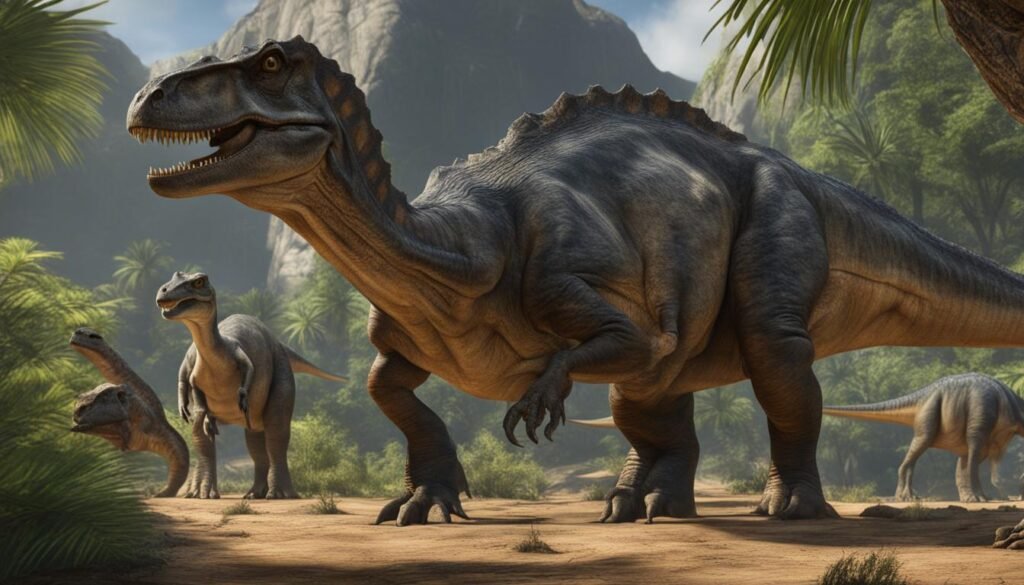
The Impact of Environmental Factors on Dinosaur Aging
One area of interest is the effect of environmental factors on dinosaur aging. Scientists have found evidence that suggests dinosaurs living in certain environments may have had different growth rates and lifespans. For example, dinosaurs in resource-rich environments may have experienced faster growth rates and longer lifespans compared to those in resource-scarce areas.
Further research is needed to fully understand the complexities of dinosaur aging and how environmental factors influenced their growth and development. By delving deeper into the fossil record and analyzing bone microstructures, scientists can continue to uncover the secrets of dinosaur aging and provide valuable insights into the lives of these ancient creatures.
| Dinosaur Species | Average Lifespan | Maximum Lifespan | Discovery Year |
|---|---|---|---|
| Triceratops | 25-30 years | 35 years | 1887 |
| Stegosaurus | 25-30 years | 35 years | 1877 |
| Velociraptor | 10-15 years | 20 years | 1924 |
| Brachiosaurus | 30-40 years | 50 years | 1900 |
Growth Rates
Growth rates play a crucial role in understanding the biology and evolution of dinosaurs. By analyzing growth rates, scientists can gain insights into factors such as weight gain, diet, environmental conditions, and species-specific traits. Different dinosaur groups exhibited diverse growth patterns, reflecting their unique adaptations and ecological roles.
One way to estimate growth rates is by measuring femur length and inferring weight gain. For example, sauropods, known for their massive size, could grow by up to 14 kilograms per day, similar to the growth rates of blue whales. This rapid growth allowed them to reach their enormous adult sizes. On the other hand, other dinosaur groups, like theropods, exhibited faster growth rates during their juvenile stage, as they needed to reach a certain size for efficient hunting.
Dinosaur Sexual Dimorphism: Uncovering the Physical Differences
Dinosaurs, like many modern animals, exhibited sexual dimorphism, where males and females have distinct physical characteristics. These differences were driven by evolutionary pressures and played a crucial role in mating season interactions and social structures within dinosaur herds. Let’s delve deeper into the fascinating world of dinosaur sexual dimorphism and the intriguing physical traits that set males and females apart.
The Evolutionary Pressure Behind Sexual Dimorphism
Sexual dimorphism in dinosaurs evolved as a result of selection pressures related to reproductive success. Males and females developed specific traits that enhanced their chances of finding mates, competing for mates, and ensuring the survival of their offspring. These traits could include differences in body size, bone structure, crest size, or even coloration.
“Sexual dimorphism in dinosaurs evolved as a result of selection pressures related to reproductive success.”
Physical Characteristics: A Tale of Contrast
One prime example of sexual dimorphism in dinosaurs is the crest size seen in species like Parasaurolophus. Male individuals exhibited larger and more elaborate crests, likely used for species recognition and attracting mates. Another notable example is the fusion of caudal vertebrae in Apatosaurus, which was more prevalent in males. These sexually dimorphic traits provide valuable insights into the complex behaviors and social dynamics within dinosaur herds.
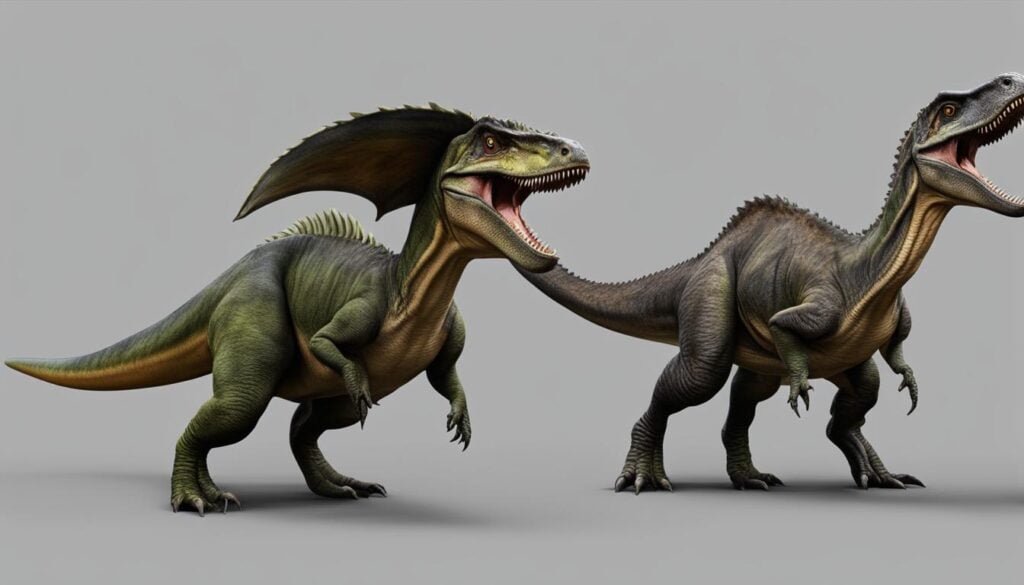
Unraveling the Mating Season and Social Structures
The differences in physical characteristics due to sexual dimorphism also shed light on dinosaur mating systems and social structures. By studying fossils and the distribution of these traits, scientists can infer how dinosaurs formed herds, established dominance hierarchies, and courted potential mates during the breeding season. These findings allow us to paint a more detailed picture of dinosaur behavior and societal dynamics.
| Dinosaur Species | Sexual Dimorphism Traits | |
|---|---|---|
| Males | Females | |
| Parasaurolophus | Larger crests | Smaller crests |
| Apatosaurus | Fused caudal vertebrae | Less fused caudal vertebrae |
| Tyrannosaurus rex | Heavier skulls | Lighter skulls |
Ontogenetic Changes
Ontogeny refers to the developmental changes organisms go through from conception to death. In the case of dinosaurs, ontogenetic changes provide valuable insights into their biology and adaptation strategies. From embryonic development to post-hatching growth, every stage of a dinosaur’s life contributes to our understanding of their evolution. Environmental factors also played a significant role in shaping ontogenetic shifts.
During embryonic development, dinosaurs underwent remarkable transformations. Fossil evidence suggests that dinosaur embryos grew rapidly, developing from small, fragile creatures into fully formed juveniles within the egg. Environmental factors like temperature and humidity influenced embryonic growth and survival rates. Scientists have also discovered that some dinosaur species laid eggs in nests, providing enhanced protection and care for their developing offspring.
After hatching, dinosaurs entered a phase of rapid growth and development. Post-hatching growth rates varied among different dinosaur groups. For example, studies on the long-necked sauropods have shown that they experienced an impressive rate of growth, gaining up to tens of kilograms per day. These growth rates were influenced by factors such as diet, environmental conditions, and species-specific traits. By analyzing the ontogenetic changes in bone structures, scientists can gain insights into how dinosaurs adapted and evolved in response to their surroundings.
The Role of Environmental Factors
Environmental factors played a crucial role in the ontogeny of dinosaurs. Changes in climate, vegetation, and predator-prey dynamics influenced the growth and development of these prehistoric creatures. For example, during periods of environmental stress, such as droughts or food shortages, dinosaurs may have experienced stunted growth or slowed development. By studying the relationship between dinosaur growth patterns and environmental factors, scientists can gain a deeper understanding of the challenges these animals faced during their lifetimes.
In conclusion, ontogenetic changes provide valuable insights into the biology and adaptation of dinosaurs. From embryonic development to post-hatching growth, each stage of a dinosaur’s life reveals important clues about their evolution. Factors such as environmental conditions, diet, and species-specific traits all shaped the ontogeny of dinosaurs. Further research in this field will continue to expand our knowledge and shed light on the fascinating world of prehistoric creatures.
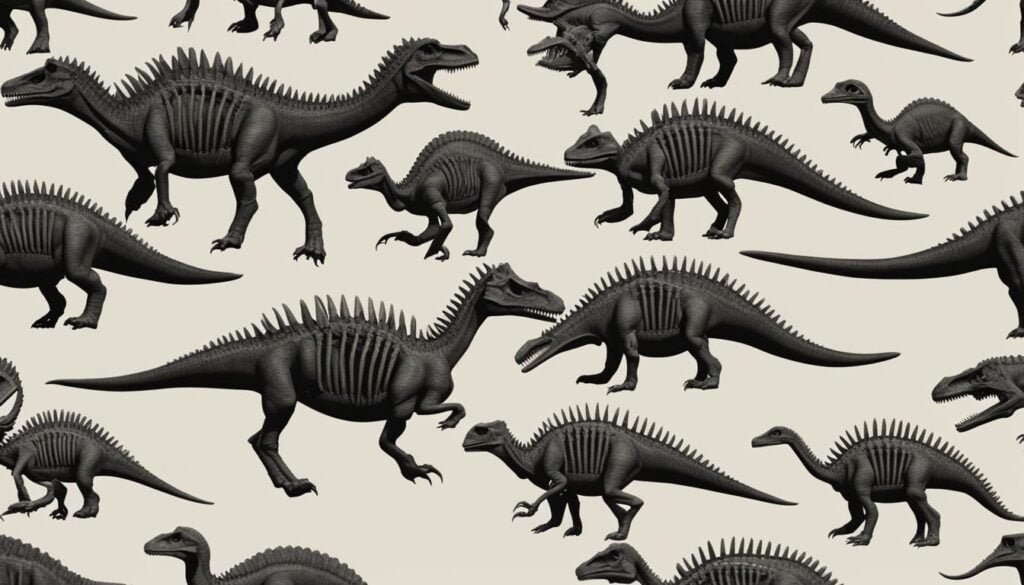
| Ontogenetic Changes in Dinosaurs | Developmental Stage | Key Findings |
|---|---|---|
| Embryonic Development | Fossil evidence | – Rapid growth and development – Influence of environmental factors – Nesting behavior |
| Post-Hatching Growth | Bone structure analysis | – Rapid growth rates in some species – Diet and environmental factors – Species-specific traits |
| Role of Environmental Factors | Climate, vegetation, predator-prey dynamics | – Influence on growth and development – Relationship between environmental conditions and dinosaur lifetimes |
Growth Adaptations
Dinosaurs developed a range of growth adaptations that allowed them to thrive in diverse environments, exhibiting extraordinary variations in body size, bone structure, metabolism, and evolutionary diversification. These adaptations played a significant role in their evolutionary success and shaped their physical characteristics.
One of the most remarkable growth adaptations in dinosaurs is their body size. Some dinosaurs like sauropods, such as the long-necked Diplodocus, evolved elongated necks and tails, enabling them to reach high vegetation and sustain their massive size. In contrast, theropods, like the fierce Tyrannosaurus rex, developed lightweight skeletons, allowing for agile movement and efficient hunting. These different body sizes and structures were essential for dinosaurs to occupy different ecological niches and thrive in various habitats.
Metabolism also played a crucial role in dinosaur growth adaptations. Some dinosaurs had high metabolic rates, allowing for rapid growth and development. For example, the small, bird-like dinosaurs called troodontids had high metabolic rates similar to modern birds and mammals. In contrast, larger dinosaurs like the sauropods had lower metabolic rates, enabling them to sustain their enormous size with less energy expenditure.
| Adaptation | Description |
|---|---|
| Body Size | Dinosaurs exhibited a wide range of body sizes, from small, agile predators to massive herbivores. |
| Bone Structure | Dinosaur bones were adapted to support their body weight and withstand physical stresses. |
| Metabolism | Different metabolic rates allowed dinosaurs to grow at varying speeds and sustain their energy needs. |
| Evolutionary Diversification | Growth adaptations contributed to the diversification of dinosaur species and the occupation of different ecological niches. |
“Dinosaur growth adaptations enabled these ancient creatures to adapt to and thrive in a wide range of environments, giving rise to a remarkable diversity of species. From the towering sauropods to the swift and agile theropods, dinosaurs developed unique traits that allowed them to survive and prosper for millions of years.”
The study of growth adaptations in dinosaurs sheds light on their remarkable evolutionary history and the ways in which they adapted to changing environments. The diversity of growth adaptations in dinosaurs is a testament to their resilience and ability to occupy various ecological roles. Further research and analysis of dinosaur growth patterns and adaptations will continue to enhance our understanding of these fascinating prehistoric creatures.
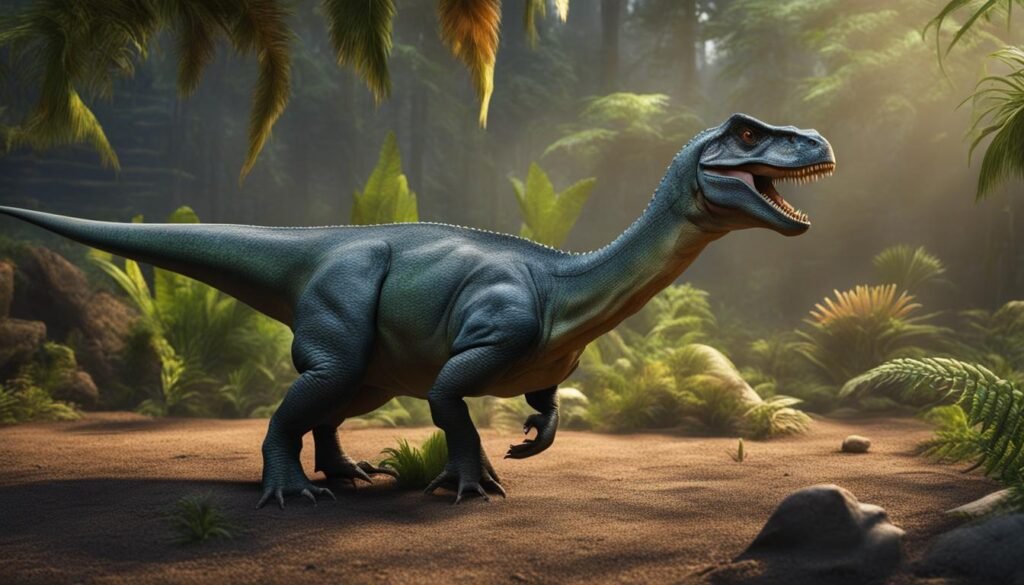
Conclusion
Studying dinosaur growth patterns and life stages provides valuable insights into their biology and evolution. The field of dinosaur biology has been revolutionized by the study of osteohistology, which focuses on the microscopic structure of dinosaur bones. Through this research, scientists have been able to reconstruct growth curves and analyze late developmental patterns, allowing them to compare growth rates, estimate longevity, and gain a deeper understanding of dinosaur development.
The evolutionary insights gained from studying dinosaur growth have shed light on the unique adaptations that allowed these prehistoric creatures to thrive in diverse environments. From changes in body size to adaptations in bone structure and metabolism, dinosaurs evolved various strategies to survive and thrive. The elongated necks and tails of sauropods, for example, enabled them to access high vegetation, while the lightweight skeletons of theropods made them efficient hunters.
While our knowledge of dinosaur growth patterns and life stages has significantly expanded, there is still much to learn. Continued research in the field of dinosaur growth will further enhance our understanding of these fascinating creatures. By exploring new research directions, such as the application of advanced imaging techniques to analyze bone microstructure, scientists can continue to uncover the hidden secrets of dinosaur biology and evolution.

